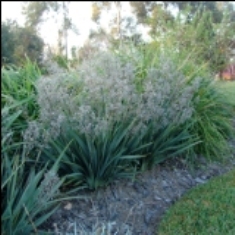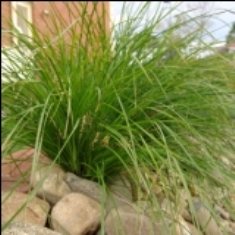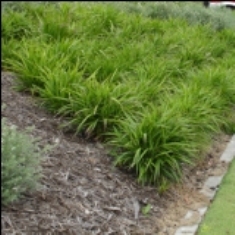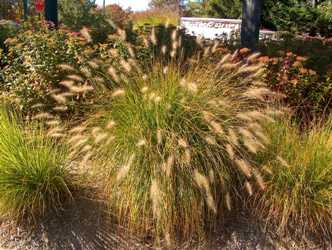|
Lawn Substitutes for Green LivingLawn substitutes are an important part of a water wise landscape. One of the key principles of Xeriscape or waterwise landscaping is keeping turf areas practical. Reducing your lawn to a practical size allows you to enjoy all the great recreational benefits of a lawn, while creating a more efficient, sustainable, and easy to maintain landscape.
Once you have determined the right size turf area, you need a lawn substitute to beautify the rest of the area. There are many non plant alternatives (hardscape) such as pavers, rock, mulch, and concrete; but these do not provide all the environmental benefits that a planted area will provide. Replacing part of your lawn with other types of plants continues removing carbon dioxide from the air, produces oxygen, reduces urban heat islands, and removes pollutants from the air. The lawn substitutes suggested below all share some important characteristics; they are low water use plants, they have low fertilizer needs, they are resistant to pests and diseases, and they do not require mowing. While there are many good plant varieties to use, these are some of my favorites.

Dianella Cassa Blue is one of a group of exciting new lawn substitutes from Australia. Marketed under the name of "Celebrated Plants", Cassa Blue is tough, sturdy and easy to maintain with a low water use. It's stunning compact blue foliage makes a great contrast to a green lawn. Cassa Blue grows 18 to 24 inches, and puts on a great display of rich blue flowers in spring. It is best suited for the southern tier of states as it is hardy to about 20 degrees. Drought tolerant, tolerant of extreme heat, very pest and disease resistant make this a great lawn substitute!

Lomandra Breeze is another excellent Australian import. It has a nice fine texture and is medium green in color, growing 2 to 3 feet tall. Breeze grows best in full sun to light shade, and produces cream colored flowers in spring. Like the other Australian varieties it is best for the southern states, hardy to USDA zone 7.
Dianella Tasred (Dianella tasmanica) has a very unique foliage color. It is an intense red at the base, gradually turning greener towards the tips. This is another of the Celebrated Plants from Australia, with compact growth of 18 to 24 inches. Like the other Dianellas, tasred produces nice blue flowers in spring and provides a nice contrasting color to your lawn.

Dianella Little Becca has very nice glossy dark green foliage and stays low, only growing 1 - 2 feet tall. Little Becca tolerates extreme heat and humidity, and is very easy to grow. Use it in sun or part shade in the southern states.
Creeping Rosemary (Rosmarinus officinalis) is a great lawn substitute that also allows you to use fresh rosemary from your landscape in your kitchen. Very drought and heat tolerant, Creeping Rosemary grows 2 - 3 feet tall and has nice dark green foliage with blue flowers in spring. This is another variety for the southern states as it is only hardy to USDA zone 8.

Dwarf Fountain grass (Pennisetum alopecuroides 'Hameln') is an ornamental grass that works in both the South and the North, as it is very cold hardy to USDA zone 4. Very fine textured, it grows 20 - 30 inches tall and produces nice beige flowers in summer. It is drought tolerant and easy to grow and maintain.
Hard Fescue (Festuca longifolia) is a waterwise variety that works best in the northern climates as it doesn't tolerate extreme heat. It grows in sun or shade (actually does best with a little shade), and forms a nice 4 - 6 inch carpet of grass. It has a look and feel of a traditional lawn, but is very water wise, should not be mowed, and does not tolerate much traffic.
Reducing the size of your turf areas with these lawn substitutes is another step towards green living. It allows you to enjoy the benefits of a planted area, while reducing your water use, fertilizer and pesticide use, and reducing the time you spend mowing. |
